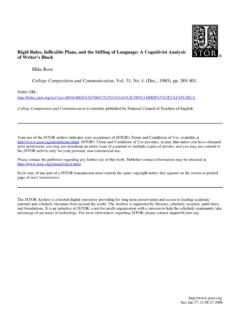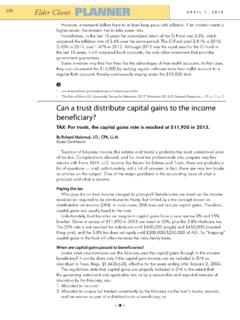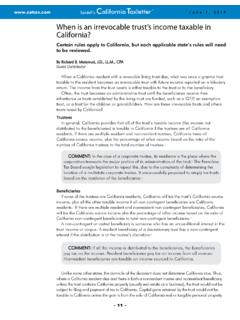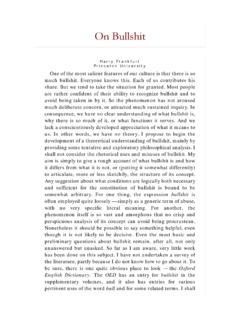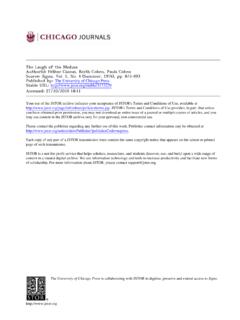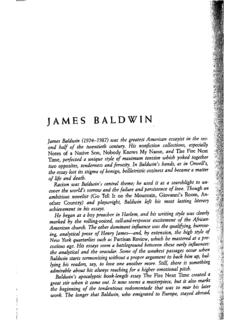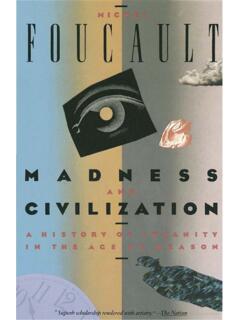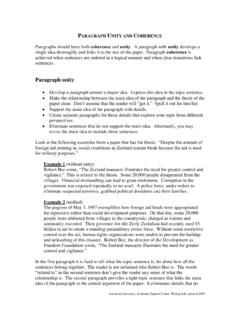Transcription of Jacques Derrida, “Structure, Sign, and Play in the ...
1 Jacques derrida , Structure, Sign, and Play in the Discourse of the Human Sciences 1 (1970). Perhaps something has occurred in the history of the concept of structure that could be called an event, if this loaded word did not entail a meaning which it is precisely the function of structural or structurality thought to reduce or to suspect. But let me use the term event . anyway, employing it with caution and as if in quotation marks. In this sense, this event will have the exterior form of a rupture and a redoubling. It would be easy enough to show that the concept of structure and even the word structure itself are as old as the epist m that is to say, as old as western science and western philosophy and that their roots thrust deep into the soil of ordinary language, into whose deepest recesses the epist m plunges to gather them together once more, making them part of itself in a metaphorical displacement.
2 Nevertheless, up until the event which I wish to mark out and define, structure-or rather the structurality of structure although it has always been involved, has always been neutralized or reduced, and this by a process of giving it a center or referring it to a point of presence, a fixed origin. The function of this center was not only to orient ; balance, and organize the structure one cannot in fact conceive of an unorganized structure but above all to make sure that the organizing principle of the structure would limit what we might call the freeplay of the structure. No doubt that by orienting and organizing the coherence of the system, the center of a structure permits the freeplay of its elements inside the total form.
3 And even today the notion of a structure lacking any center represents the unthinkable itself. Nevertheless, the center also closes off the freeplay it opens up and makes possible. Qua center, it is the point at which the substitution of contents, elements, or terms is no longer possible. At the center, the permutation or the transformation of elements (which may of course be structures enclosed within a structure) is forbidden. At least this permutation has always remained interdicted 2 (I use this word deliberately). Thus it has always been thought that the center, which is by definition unique, constituted that very thing within a structure which governs the structure, while escaping structurality.
4 This is why classical thought concerning structure could say that the center is, paradoxically, within the structure and outside it. The center is at the center of the totality, and yet, since the center does not belong to the totality (is not part of the totality), the totality has its center elsewhere. The center is not the center. The concept of centered structure although it represents coherence itself, the condition of the epist m as philosophy or science is contradictorily coherent. And, as always, coherence in contradiction expresses the force of a desire. The concept of centered structure is in fact the concept of a freeplay based on a fundamental ground, a freeplay which is constituted upon a fundamental immobility and a reassuring certitude, which is itself beyond the reach of the freeplay.
5 With this certitude anxiety can be mastered, for anxiety is invariably the result of a certain mode of being implicated in the game, of being caught by the game, of being as it were from the very beginning at stake in the game. 3 From the basis of what we therefore call the center (and which, because it can be either inside or outside, is as readily called the origin as the end, as readily arch as telos), the repetitions, the substitutions, the transformations, and the permutations are always taken from a history of meaning [sens] that is, a history, period whose origin may always be revealed or whose end may always be anticipated in the form of presence.
6 This is why one could perhaps say that the movement of any archeology, like that of any eschatology, is an accomplice of this derrida , Structure, Sign, and Play . reduction of the structurality of structure and always attempts to conceive of structure from the basis of a full presence which is out of play. If this is so, the whole history of the concept of structure, before the rupture I spoke of, must be thought of as a series of substitutions of center for center, as a linked chain of determinations of the center. Successively, and in a regulated fashion, the center receives different forms or names. The history of metaphysics, like the history of the West, is the history of these metaphors and metonymies.
7 Its matrix if you will pardon me for demonstrating so little and for being so elliptical in order to bring me more quickly to my principal theme is the determination of being as presence in all the senses of this word. It would be possible to show that all the names related to fundamentals, to principles, or to the center have always designated the constant of a presence eidos, arch , telos, energeia, ousia (essence, existence, substance, subject) aletheia, transcendentality, consciousness, or conscience, God, man, and so forth. The event I called a rupture, the disruption I alluded to at the beginning of this paper, would presumably have come about when the structurality of structure had to begin to be thought, that is to say, repeated, and this is why I said that this disruption was repetition in all of the senses of this word.
8 From then on it became necessary to think the law which governed, as it were, the desire for the center in the constitution of structure and the process of signification prescribing its displacements and its substitutions for this law of the central presence but a central presence which was never itself, which has always already been transported outside itself in its surrogate. The surrogate does not substitute itself for anything which has somehow pre- existed it. From then on it was probably necessary to begin to think that there was no center, that the center would not be thought in the form of a being-present, that the center had no natural locus, that it was not a fixed locus but a function, a sort of non- locus in which an infinite number of sign-substitutions came into play.
9 This moment was that in which language invaded the universal problematic; that in which, in the absence of a center or origin, everything became discourse-provided we can agree on this word that is to say, when everything became a system where the central signified, the original or transcendental signified, is never absolutely present outside a system of differences. The absence of the transcendental signified extends the domain and the interplay of signification ad infinitum. Where and how does this decentering, this notion of the structurality of structure, occur? It would be somewhat naive to refer to an event, a doctrine, or an author in order to designate this occurrence.
10 It is no doubt part of the totality of an era, our own, but still it has already begun to proclaim itself and begun to work. Nevertheless, if I wished to give some sort of indication by choosing one or two names, and by recalling those authors in whose discourses this occurrence has most nearly maintained its most radical formulation, I would probably cite the Nietzschean critique of metaphysics, the critique of the concepts of being and truth, for which were substituted the concepts of play, interpretation, and sign (sign without truth present); the Freudian critique or self-presence, that is, the critique of consciousness, subject, of self- identity and of self-proximity or self-possession.
